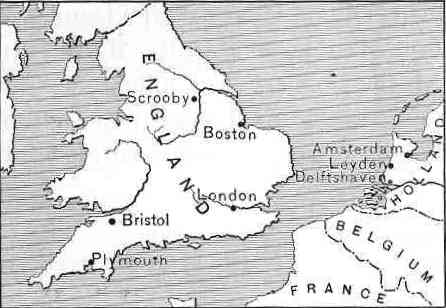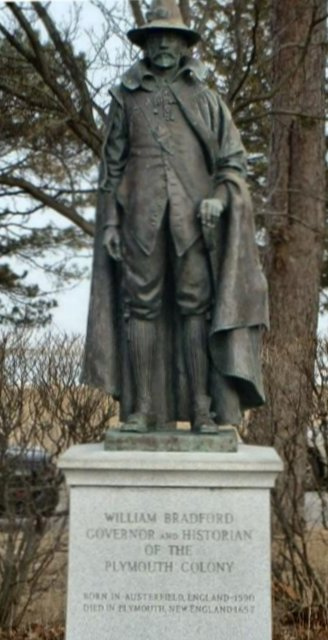
Online Texts for Craig White's Literature Courses
|
Of Plymouth Plantation by William Bradford
Instructor's Overview of Chapters I-IV |
|
Instructor's Notes:
-
Bradford (1590-1657) was governor of the Pilgrims' colony at Plymouth and a member of the church community from its earliest days in England and sojourn in Holland.
-
The early chapters are difficult but priceless—difficult because the English diction and style are 400 years old, priceless because an actual participant describes the religious and cultural background for the first permanent settlement of English-speaking colonists and the rise of America's dominant culture.
-
For those unfamiliar with this history, a difficulty with Bradford's text and its historical background is the many names for the group, among them Pilgrims, Puritans, Separatists, Non-Conformists, Radical Protestants, etc.
Chapters overview:
A short reading assignment—only the first 4 chapters (28 pages in paperback version), but they're the hardest chapters to read because Bradford is looking back and establishing the Pilgrims' small colony in this history of Reformation Europe.
Chapter 1 identifies Pilgrims with the Protestant Reformation against the Catholic Church and its influences in the 1500s and 1600s (see below)
Setting: "North parts" refers to Germany, England, and other areas of Northern Europe where Protestant Reformation was centered
The Pilgrims as radical Protestants were trying to establish a separate religious order from the "Church of England," which they associated with the Catholic Church or "popery." (The Church of England is Protestant but retains many Catholic influences--for example, that church's nearest American relation is the Episcopal Church.)
In contrast to the ceremony and splendor of Catholic church styles, the Puritans wish to return to an "ancient purity" and "primitive order" based on the simpler church community of the Apostles in the generation following Jesus's life on earth. (Such impulses remain a motive of Modern Evangelical Protestantism.)
The Church of England represents the bad old ways against which Bradford and other Protestants rebel, and for which they are "hunted and persecuted on every side," forcing them to leave their homes
end of chapter 1: English communities resolve to go into "the Low Countries" = the Netherlands, Holland

Chapters 2-4: concerns how the Pilgrims, persecuted in England, first moved to Holland ("the Low Countries" or The Netherlands).
In the Low Countries, the Pilgrims are much like later immigrants to America. They work hard and appreciate the Dutch atmosphere of religious tolerance, but . . .
Their children start assimilating to the freer Dutch ways. The adult Pilgrims don't like this. In Holland, they basically refuse the typical immigrant pattern.
Some then decide to move to "some of those vast and unpeopled countries of America, . . . where there are only savage and brutish men . . . little otherwise than the wild beasts . . . ."
In brief, the Pilgrims have no intentions of assimilating to the "savage and Brutish" Indian culture then in America.
In this regard the Pilgrims differ from later immigrant groups, who come to America with the idea of "joining up" with the existing system of government and economics (more or less)
The Pilgrims thus resemble the Jews in Exodus and their attitude toward the "Promised Land" of Canaan, where they are told not to intermarry or take up Canaanite ways.
More on Protestant Reformation
Pilgrims and Puritans as part of "Protestant Reformation" in which Protestant churches and denominations separated from Catholic church that dominated Europe in earlier centuries
1517: Martin Luther publishes 95 Theses protesting errors of Catholic Church
Protestant Reformation peaks in 1600s, "the Seventeenth Century"--marked by wars of religion
1700s: Enlightenment or Age of Reason cools down religious attitudes, establishes secular governments like ours, but . . .
The Protestant Reformation never really ends . . . always new churches and denominations springing up in protest of errors of older churches + attempt to return to earlier, simpler, stripped-down style of the early church
For example, today the old churches like Presbyterians, Lutherans, even Methodists are struggling to survive as people shift to
evangelical churches like Church of Christ, Assembly of God, Baptist Church, Missouri Synod Lutheran
or "non-denominational" churches like Lakeview, the Vineyard, the Emerging Church movement
Eventually these new movements will become older denominations and cool off, upon which another phase of Protestant Reformation will pick up
Reasons for this information:
Pilgrims as part of Protestant Reformation
American dominant culture established as Protestant, remains almost exclusively Protestant until arrival of Irish Catholics in 1840s-50s
Protestantism compatible with other aspects of American character: individualism, capitalism, nuclear family values, plain style
Evangelical Protestantism: world moves forward to future but heart reaches back to past
Protestant Reformation essential movement toward modern world of change, individualism
Whatever an immigrant's religion, they're assimilating to a culture based partly on Protestantism ("base culture")
Protestantism compatible with dominant culture: emphasizes personal literacy, reading Bible for oneself (questionable how much this is done, but ideal and motive for reading)

